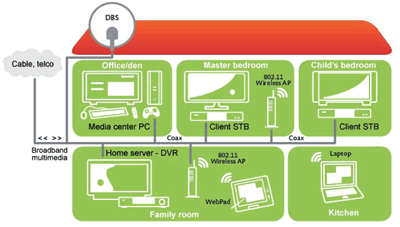Enable triple-play video in home nets with coax
EETimes
http://www.eetimes.com/
11-16-07 by Anton Monk, Co-Founder and Chief Technology, Officer, Entropic Communications Inc.
The concept of the digital home and what it can mean to the delivery of high-quality entertainment opens the door to a variety of fascinating and challenging technical issues. While applications in the digital home have undeniable appeal (e.g. high-quality video in the form of HDTV, SDTV and DVD, and audio) the delivery of those applications depends on the availability of a high-throughput, high-reliability network that can move throughout the house. Thus, product developers and service providers are now focused on the most effective ways of implementing such a network. The nature and strength of demand will depend on the quality and reliability of the video and multimedia experience. Unlike the forgiving attitude they have when it comes to Internet traffic (e.g. poor streaming video quality, slow download times and inconsistent service), consumers will demand premium performance from their whole-home network when it comes to the delivery of A/V on such platforms as PCs and DVRs.
Demands on home nets
The kind of home network that
will meet the quality-of-experience
demands of users will have
to support HDTV, SDTV, VoIP, gaming,
data, audio and other types
of multimedia applications. The
delivery platform will be a DVR
or some other kind of storage
device, such as a home media
gateway, network-attached storage
or even a PC. Premium content
will be sourced either from
typical pay-TV service provider
networks or over-the-top service
providers.
Network bandwidth requirements for whole-home entertainment networks are on the order of 100Mbps of net throughput. This requirement arises from the need to support multiple streams of up to 20Mbps of HD video content. In addition, trick modes such as fast forward and rewind can place even higher demands on individual streams. Depending on the traffic flow architecture, streams may also be required to traverse the network multiple times.

A home network that delivers quality entertainment experience will be one that supports the data rate required by multiple HDTV and SDTV streams and that offers the best packet error rate (PER), plus low jitter and delay for voice and gaming. The core requirements of a home network include:
From a practical perspective, the home network must be in sync with realistic consumer price points, cannot be negatively impacted by the appliances or the home network in the house of a neighbor, and cannot be negatively impacted by other appliances or home networking products being used within the user�s own home.
Crucial consideration
When it comes to data rate, the
inescapable conclusion is that
the home network must support
peak data rate per stream. A
complicating factor is contained
within the reality that streams can
peak simultaneously. Much of the
broadcast content in the United
States comes in MPEG-2, with
average data rates of between
2Mbps and 3Mbps, and peak rates
of approximately 9Mbps (in SDTV
MPEG-2 broadcasts). In contrast,
streams of video-on-demand over
SDTV have a constant bit rate of
4-5Mbps.
Another complication for service providers comes when a subscriber decides to home network American TV Standards Committee (ATSC) data, which means that the service provider will have to make this kind of network or terrestrial content available to subscribers. As a result, service providers will have to allocate the data rate for home networking ATSC data streams at 19Mbps, which may not reflect considerations for their own HDTV data rates.
To accommodate these high peak data rates for premium content services, service providers need to ensure some level of guarantee for the bandwidth they need on the in-home network. The alternative is unacceptable� if personal or nonpremium content services result in performance degradation of pay-TV services, the service MoCA technology can provide a backbone for whole-home entertainment networks of wired and wireless products. EE Times-Asia | November 16-30, 2007 | eetasia.com Enable triple-play video in home nets with coax COAX provider will face calls to their customer support departments. Multimedia over Coax Alliance (MoCA) addresses this need through the use of advanced parameterized QoS (PQoS) capabilities in the upcoming MoCA 1.1 specification. PQoS enables bandwidth to be reserved on the home network. An application can request to set up a flow with certain traffic parameters, such as desired bandwidth. If the flow can be supported in the network, it is granted to the requesting application and guaranteed until it is no longer needed. PQoS allows operators and service providers to comfortably protect their premium content while allowing the convergence of their services with non-premium/personal content.
A home network would also require the following:
Coaxial wiring
Various media exist for home
networking. Due to its robustness
and ease-of-installation, MoCA is a
good backbone for entertainment
networking in the home. Coaxial
outlets usually sit where TVs are
expected to be located. MoCA
also provides a suitable mechanism
for increasing Wi-Fi coverage
throughout the home. MoCA is
also the only deployed coaxial
solution that coexists with cable
operator upstream frequency
plans used by cable modems.
Coaxial wiring and Cat5 wiring are comparable to each other in terms of being high-bandwidth media for video home networking. The big difference makes itself felt in the realm of ubiquity. Coax is much more widespread (appearing in 100 times as many whole homes as Cat5 wiring) and supports more than 250 million video delivery vehicles such as TVs, DVRs, DVD, VCRs, cable modems and STBs.
Coax has the bandwidth to support multiple frequency channels (i.e. separate homes won�t degrade each other even if they aren�t physically isolated from each other). Also, coax is a shielded medium protected from interference from appliances in the user�s or in a neighbor�s home. Coax also supports extensive bandwidth above 860MHz, enabling a future road map of increasing data rates.